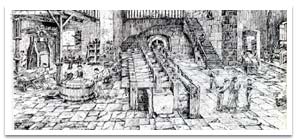In a deed of the first half of the XIII century one can
read "Item concedunt etaim et ectanioem faciendi pilam in Clarito
seu in flumire..." the term “pila”indicates the bath
where the rags were chopped up for the production of paper, and this proves
that in that period there was at least one paper-mill in activity.
The will of a merchant of Amalfi, Margarito Marcagella in 1268, reads
"habeo in Amalphia de coclone uncias duodecim auri, item habeo resini
ires charta" proof that the merchant bought cotton to transform into
paper.
A document of Ravello of 1289 mentions the "carta bambagina o bombicina", made with cotton rags, cotton that at the time was one of the principal wares in the commerce of Amalfi, on the coast line of the marine city there was a “Platea Bambacariorum”, the square of the textile merchants…
The royal edict did not however manage to limit the use of paper, after
the Council of Trento that ordered all parishes to keep registers of births
and deaths there was an ulterior increase in use of paper.
After the solicitors and the churchmen , the universities and various
offices of the Reign began to use paper for their deeds and in Religious,
civil and private archives of many Italian cities documents with the water-mark
of Amalfi can be found.
The best quality paper began to be used at the Anjou and Aragon courts,
in the Spanish vice-realm and later still in the Bourbon court, it was
also very popular in the XV century and many foreign authors had their
works published in Naples utilizing the precious product.
 |
Antica cartiera amalfitana del
XVIII sec. |
In the XIII century the production of paper on the Amalfi Coast became
a business in continual expansion especially with the gradual transformation
of the water-mills into paper mills, a document of 1380 confirms this,
it reads “in quo predicto molendino facta est balkeria ad faciendum
cartas bombicinas". The paper mills were situated in the actual Valle
dei Mulini, along the course of the river Canneto or Chiarito, that also
provided water for the iron-works, that was active between the XIV century
until the early years of the XIX century….